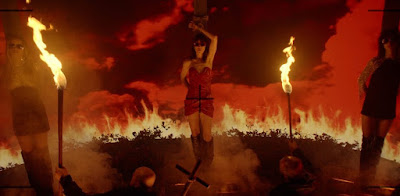Not that anyone (I don’t think) actually believes that television and film are actually magic, but they get described in those terms often enough. And I get it, you’re talking about signals sent through the air (or as pulses down cables) that captivate us, make us laugh and cry and scream. Film and television show us the impossible from thin air. How is that not magic?
But of course it’s not. It’s technology, it’s editing, it’s special effects. It’s the illusion of continuity and motion, of images reproduced from little blobs or blocks of color, of meaning created through camera angles and lighting and music and more besides. The whole point of illusion is to show us things that aren’t there, or that aren’t what they appear to be.
Late Night With The Devil is, for the most part, a well-crafted story about illusion; it’s a story about what seems to be versus what is, and the price paid for success.
It’s 1977, and Jack Delroy is one of the most successful late-night talk show hosts on the air. Every night, his show “Night Owls” brings viewers the mix of sketch comedy, banter, and celebrity interviews one would expect from the genre, consistently at the top of the ratings without ever quite managing to dethrone late-night powerhouse Johnny Carson. But Delroy’s suffered a number of setbacks of late, including the untimely death of his wife Madeleine from cancer. Ratings are slipping, and forays into more sensationalistic waters haven’t really turned things around. His contract is up for renewal, and so Jack Delroy has one last chance to keep his show on the air. It’s Halloween night, and he has a very special line-up of guests ready to go. There’s the celebrated spirit medium Christou, a former magician-turned-skeptic named Carmichael Haig, and a young psychologist named June Ross-Mitchell. Dr. Ross-Mitchell has written a book about her work with a young girl named Lilly, who seems to suffer all of the symptoms of demonic possession.
It's Halloween night, 1977, and Jack Delroy is hoping for an audience with the devil.
In terms of artifice, period pieces are always risky, but this film does a nice job of capturing the 70s zeitgeist – the clothes, the color palette, the corny jokes, the cultural references, the sexism – and brings together a number of historical and pop cultural moments in a pleasing way. You’ve got the emergent religious cult weirdness of the late 60s/early 70s with allusions to the Bohemian Grove, the Church of Satan, the Process Church, and anachronistically a little bit of the Branch Davidians. On top of that you’ve got the nascent interest in demonic possession sparked both by films like The Exorcist and interest in parapsychology, both of which set the stage for the recovered-memory Satanic panic of the 1980s. The film opens with lots of footage from riots and protests and sensational crimes like the Manson murders, setting the stage as a U.S. in turmoil, feeling like everything is falling apart. Delroy’s show is the kind of place people come to for pleasant refuge in a world where maybe…just maybe…the devil is real. This film has a very good idea of what its sandbox is, and it’s patient about building its world, laying detail in carefully, and (with one annoying exception) does a good job of not overexplaining things, leaving the audience to piece things together as everything comes to a head. The performances are a little on the stagey side, and although that makes sense for television, it’s the case even in the moments that are supposed to be behind the scenes; the exception to this being the actress playing Lilly, who is just fantastic – extremely unnerving but with a lot more restraint that I usually see from someone asked to play her role.
And this speaks to the film’s biggest problem, and it’s an appropriate one – verisimilitude. The conceit is that we’re watching the master tape of a live television broadcast that ended horribly, and when the focus is on the television show, it works really well. But there are these interstitial moments that are supposed to be what’s going on while they’re on commercial break, and they’re shot as fairly clean black-and-white handheld footage. What television network would have cameramen roaming around backstage filming confidential conversations? It doesn’t need the found-footage conceit to work, and it just ends up getting in the way. Worse, it dispels the illusion, and for a story where willingness to believe leads all kinds of bad places, it’s an irritating misstep in an otherwise well-made film.
IMDB entry
Available on Amazon




